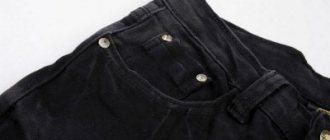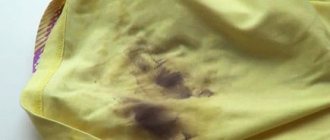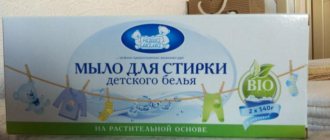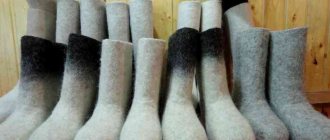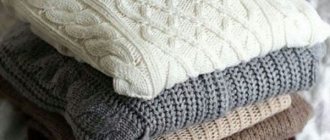Now there are many varieties of things of different colors and materials from which they are made.
In order for them to retain their original appearance for a long time, it is necessary to adhere to certain rules: this includes the choice of washing powder and fabric softener, washing mode and temperature, and also, it is worth paying due attention to proper sorting.
Read the article about what things can and cannot be washed together in a washing machine and how to do it correctly.
Possibility of joint processing
Not all colored fabrics can be washed together.
It is important to consider two nuances. The first is the combination of colors of things, the second is the combination of materials from which they are made. When washing several colored items, it is recommended to follow these rules:
You can wash items of similar color shades together. This applies to the combination of blue and green clothes, yellow and orange, red and pink.- You cannot put clothes made from contrasting fabrics together in the machine or wash them by hand. This applies to yellow and blue clothes, green and red, blue and orange, gray and orange, blue and pink.
- You can wash colored items made from the same or matching fabrics together. This applies to items made of cotton, linen, chintz and calico. It is allowed to put colored synthetic items in the wash together. It is permissible to wash cashmere and wool clothes together. You can combine clothes made of silk with synthetics.
- You cannot wash colored linen and cotton linen with synthetics together. This also applies to items made of wool and cotton, wool and linen.
https://www.youtube.com/watch?v=ytcreatorsru
Even if two items are the same color but made from different materials, they should not be washed together.
Together with black
It is recommended to process such products separately, especially if one of them is light in color. It may take on a different color when washed. Also, you should not combine black and colored underwear made from different materials. In this case, it may fade.
Colored and
black clothes
Can be washed together only in two simultaneous cases. Both items must be made from the same material or from two washable fabrics (cotton and linen). The colored product must be dark.
When washing black and dark blue or black and dark brown items, the second item will not be harmed in either case. Even if any color defect occurs, it will not be noticeable.
Such items must not be co-washed under any circumstances. White linen almost always suffers from co-washing.
It often turns a different shade and becomes unwearable. When sorting clothes before washing, you should first separate colored items from white ones.
Read about how to properly wash white clothes here.
Features of using bleach
When working with aggressive chemicals, it is important to follow safety rules - not only sheets and washing machine parts can be damaged, but you too. Safety rules when working with chlorine-containing solutions:
- When bleaching, wear gloves and a mask. Contact of the substance with the skin causes burns, corrosion, and allergies.
- It is not advisable to use a stain remover on colored fabrics - the stain will come out, but along with it the color will lose its saturation.
- Do not use on leather, wool and silk items. Stains from them are generally very difficult to remove; compositions with chlorine will only spoil the material or cause the appearance of yellowness. Use is allowed on cotton, linen and synthetic fabrics.
- If the container with “Belizna” has been opened for a long time - six months or more, it is not worth using it, since the chemical effect of the composition is noticeably reduced.
Sorting and preparation rules
It is recommended to adhere to the following tips:
- First, sort the laundry by color. Separately lay out white, black and colored items.
- Carry out separate sorting of colored products. Place clothes of dark and light shades separately.
- Items sorted by color are divided depending on the type of fabric. You can group clothes made from cotton and linen, and put them separately from items made from wool and silk. Place synthetic items separately. Sort fine colored and lace underwear into a separate pile.
- Arrange items depending on their washing mode. Colored towels and bed linen are placed separately. They are washed at a higher temperature. Washing other items should be done at low temperatures.
- Sort products based on their degree of contamination. Very dirty clothes and items with old stains should be placed in a separate pile.
If items are heavily soiled, it is recommended to prepare them for washing by soaking. You can use laundry soap for this.
Rub it on the problem area of the item and leave it for an hour. You can also soak the entire item in soapy water for several hours.
Before any washing, multi-colored laundry should be turned inside out. This way it will better retain its color.
When washing colored laundry, you need to consider simple recommendations:
- It is forbidden to wash colored items together with black laundry. Failure to follow this recommendation may result in damage to bright items.
- After purchasing a colored item, you must wash it with items of a similar color scheme. If you bought a blue T-shirt, then you can safely wash it with blue towels, since if it fades, the towels will get a richer shade.
- To wash colored items, use soft water. To determine the level of hardness, you can use the following advice: add 25 grams of soap to 250 ml of hot water; it should dissolve quickly without sediment if the water is soft. To make water soft, you can use modern scientific developments - the products are available on store shelves.
- Before washing, be sure to soak bright tights, stockings, and socks in the prepared solution. To do this, you need to mix a glass of warm water with 50 grams of boric acid. Leave the solution for an hour.
- Workwear and colored items with heavy soiling need to be soaked before washing. It is necessary to use laundry soap, boiling water, soda and kerosene. Add 75 grams of laundry soap to the water, then add a spoonful of soda, add kerosene in an amount of 180 ml. Rub this mixture onto the dirt. Leave the products in this position for at least 7 hours. Then wash as usual.
- In order for items made from linen to retain their color brightness, it is important to wash them correctly. It is necessary to add vinegar when washing. Use cool water to rinse.
- In order for pink, yellow, and blue clothes to remain bright, you need to rinse them in a solution with 9 percent vinegar. For machine care, use 125 ml of 95% vinegar. For blue and red products you will need 15 grams of salt when rinsing.
- Mohair items must be rinsed after washing in a solution of water and glycerin. You will need 3 tablespoons of the substance. This measure will ensure color fastness and softness of the fabric.
We suggest you read: Is it possible to stretch jeans in length?
Technology for washing contrasting items
The best way to clean items of contrasting colors is hand washing in low temperature water. At the rinsing stage, you can pour a vinegar solution into the water. You need to start washing immediately, without soaking the items in hot water.
Linens in contrasting shades can be washed together if neither item is dyed. You can check this by soaking a fragment of the fabric of the product in a basin of warm water. In case of water staining, the item can only be washed separately from others.
Selecting a washing mode
When using a washing machine, it is better to use the fast or normal mode without activating the “Spin” function and set the temperature to 30 - 40°C.
Temperature
The clothes will delight the owner for a long time with the brightness of their colors and will not lose their shape if they are not exposed to hot water. Also, the type of material matters.
Water temperature for specific fabrics:
- cotton – up to 60°C;
- synthetic – up to 40°C;
- silk - up to 30°C;
- wool – up to 40°C;
- membrane – up to 40°C;
- with prints – up to 40°C.
This scheme must be followed regardless of the washing method.
Bleach and powder
Bleach is used as a stand-alone means to make materials white, and they are used together with washing powder to provide a more pronounced whitening effect and combat stains.
You can add bleaching agents every time you wash light-colored laundry.
But, there are bleaches containing oxygen. Such products are used at a water temperature of 90°C. The best effect from their use is achieved when washing laundry is white. The spots usually have different origins. Oxygen bleach is designed to remove plant stains and works at high temperatures.
Pre-wash in a machine or soak by hand - you can do it with the selected product, and add bleach at the main stage of the cleaning process.
Advice! Bleach designed for use at low water temperatures can be used at any stage.
Selecting a detergent
This type of product can be processed with both powders and gels. You can use capsules and soap.
It is recommended to choose powder in cases where a colored item needs to be cleaned from stains. This product removes dirt better. The powder is also recommended for use when colored clothes need to be washed by hand.
Capsules should be used in machine wash only. They are also suitable for soiled items. The dosage of powder in them is optimal. They also contain the required amount of stain remover.
https://www.youtube.com/watch?v=ytaboutru
Gels are more suitable for washing colored clothes in a machine. They should be chosen in cases where the fabric needs to be restored to brightness. Gels are only suitable for washing lightly soiled clothes. They are intended for use in non-hot water (up to 40C).
Laundry soap is recommended for use when soaking colored fabrics. This product should be used when the laundry is heavily soiled or the stains have been on it for a long time.
Boil white things
The boiling process is considered an excellent way to restore the original whiteness, refresh things and remove stubborn stains. It can be used both before and after washing. Before you begin this activity, you should stock up on the necessary equipment and preparations for removing stains. For boiling, it is recommended to use a large enamel bucket or pan. The selected container should only be used for boiling. Before subjecting your laundry to boiling, you should carefully read the tags on the clothes, because they indicate the fibrous composition of the product and temperature indicators.
Handwash
To wash colored items by hand, you need to follow these simple steps:
- Prepare a bowl or basin.
- Take water at room temperature.
- Add mild detergent.
- If necessary, soak the products first.
- Place the item in water with detergent and wash it with gentle movements.
- Rinse with cool water and water softener.
- Dry.
- It is important to wash things with rubber gloves.
The hand wash mode is gentle, so your colored items will delight you with their shades for a long time!
Removing stains manually
- You need to fill the container with water. A basin with a volume of twenty liters is half filled with water;
- Add a combined detergent that softens the water. This tool differs from its automatic counterpart. You can purchase a product for manual washing at any point of sale of household chemicals;
- Soak the products in the cleaning solution. You should swirl the laundry in the water a little until it is completely wet;
- We start rinsing things first in warm water, then in cold water;
- Drying clothes. You should not immediately hang such products, as they tend to stretch. The best option for drying delicate items is to lay them out on flat surfaces.
Can the same gel or powder be used for white and multi-colored?
White items can be washed with colored laundry powder, but colored items cannot be washed with white laundry powder.
White laundry powders contain various bleaches, which may cause stains or lightening of the color.
Powder for colored laundry has a color retention function, so this washing powder can be used to wash colored items and white items.
Any colored linen should not be washed with powder or gel for white items. These products contain bleach.
Often they may contain chlorine - such a substance negatively affects the quality of multi-colored linen. After washing, it may become less bright and saturated. It may appear stained.
White clothes can sometimes be washed with a powder intended for colored fabrics. But you shouldn't do this often. From constant washing, white linen may begin to turn gray or yellow over time.
Recommendations
Guided by all the above rules, you can achieve the desired results in washing any fabrics.
It is important to remember and strictly follow
- Choose the right detergents and washing powders for the types of fabrics.
- Approaches the choice of washing mode on a machine with the full degree of responsibility.
- Strictly follow all recommendations indicated on the product label.
- Properly rinse and dry clothes after a wash cycle.
Successful washing directly depends on your knowledge.
When washing different types of laundry, follow these recommendations:
- When washing white items, you need to monitor the temperature of the cycle. The recommended temperature is 30 degrees C. Do not wash white items with colored items, otherwise the white items may be damaged. Recommended washing powders - with a bleaching effect. It is this category of cleaning products that will give white things a natural color. It is recommended to dry white items in the sun, as they make the clothes whiter.
- Washing black clothes involves using a properly selected cycle program. It is strictly forbidden to load other items of other colors with the color black. Black is best washed from the inside out. In the laundry detergent market, the most popular detergents are for black clothes. Choose appropriate products. For white things - gel capsules for white, for black things - washing powder or gel capsule for black.
- Colored items are very sensitive to changes in color. Therefore, you should be careful when washing colored laundry. Choose the right washing powder for colored items and set up a cycle program for your washing machine. An important factor is the use of bleach. When doing color washes, using this type of detergent is strictly prohibited. It is better to resort to conditioner and gel capsules. You can wash different colors in one cycle, but you should avoid black and white shades on clothes. We recommend the washing mode for colored laundry - cotton, wool, delicate wash, quick wash mode.
Let's consider the main designations of the characteristics of labels on clothes and underwear:
| Symbol | Designation and brief description |
| Hand and automatic washing in a washing machine is allowed. A two-digit number may be displayed inside this designation; this indicates the temperature of the water during washing. | |
| This sign indicates the possibility of using additional modes (spin, rinse) | |
| The symbol indicates that the item of clothing can be ironed | |
| The symbol on the clothing indicates the possibility of professional dry cleaning and chemical treatment. | |
| The sign strictly prohibits washing. In this case, the item must be dry cleaned. |
Thus, to summarize the above, the effectiveness of washing directly depends on theoretical and practical knowledge
It is important to understand the basic concepts of washing, the principles of operation of a washing machine and correctly apply them in practice. The main thing is to choose the right detergent, carefully sort clothes and take the choice of operating mode of the washing machine seriously.
In the event of a breakdown or improper operation of the washing machine, you must contact a specialist or service center for diagnostics and professional replacement of spare parts and components. It is strongly recommended not to resort to repairing equipment yourself; entrust the work to a professional. There are many products used to prevent the operation of washing machines; they must be used directly at least once every 6 months. They are easy to use, just pour the powder into the designated area and run a minimal wash cycle without clothes. A special powder will remove all scale from the heating elements and clean the drum.
How to wash colored items in a washing machine
If you have chosen the machine wash mode for colored items, then you need to follow simple steps:
- Pre-soak heavily soiled items, socks and tights.
- Place items in the washing machine.
- Add mild powder and add conditioner.
- Turn on the delicate wash mode or the option with a temperature no higher than 40 degrees.
- After completing the washing program, items must be taken out and sent to dry.
We invite you to familiarize yourself with the Persistent mouse odor and effective ways to eliminate it.
What you need to know to wash a white shirt
Light-colored fabrics are the most demanding to care for; dirt on the collar and cuffs is more visible and is more difficult to remove. Washing a shirt correctly is not difficult if you follow simple rules, but you should also follow the recommendations on the clothing label.
How to wash white shirts:
- On the washing machine panel you need to set the delicate mode with the maximum temperature that the material allows. Usually this is washed at 40-60 degrees without spinning.
- Cuffs, collar area and yellow stains are treated with a chemical stain remover. You can use a natural remedy: liquid laundry soap 4 tbsp. spoons mixed with 3 tbsp. spoons of hydrogen peroxide and apply to stains, leave for 30-40 minutes before washing.
- You need to add bleach to the powder compartment, preferably oxygen-based, it is more gentle on the fabric. Don't forget about the conditioner, which should be colorless.
Important. The manufacturer places a “dry clean” sign on some products, and if you are not willing to constantly take shirts to specialized centers, it is better not to purchase such items. Of course, you can try to wash it yourself, but there is no guarantee that the item will retain its shape and color.
Note to the hostess
- When caring for items, special attention should be paid to the instructions on the tag or label.
- Always follow the temperature recommendations, otherwise the color of the product may change.
- Sort items correctly: it is recommended to wash red items together with items colored in purple, orange, and yellow shades; blue with green things. If there are only a few colored items, you can wash them by hand.
- All items must be turned inside out before washing. This measure will help protect things from shedding.
- Do not fill the drum completely.
- Bright clothes do not tolerate hot water, so it is recommended to wash them in modes with a maximum temperature of no higher than 40 degrees.
- Under no circumstances should items be left in the washing machine drum after the end of the washing program. This can lead to damage to things: they may fade.
- Do not use care products containing chlorine.
- Place colored items spaced apart on the dryer.
Colored products help us look stylish and bright in any situation. To keep things looking attractive for a long time, it is important to wash them correctly! Simple recommendations for caring for colored items will ensure their original appearance.
Rules for drying shirts
Do not dry items by throwing them over a clothesline. The shirt may become deformed and develop wrinkles that can be difficult to smooth out even with a powerful iron. It is recommended to hang laundry on hangers, and you need to make sure that the items do not touch each other while drying. If there are no free hangers at home, you can attach shirts to a line using clothespins.
To make ironing easier, you do not need to wait for the product to dry completely - slightly damp fabric is easier to iron and does not deteriorate. If the shirt is in a pile of clean laundry, you can spray it with a spray bottle.
Attention! If the underwear is made of viscose, you need to moisten the entire product at once, since local spraying will leave streaks. To do this, place it on a damp towel and wrap it in a roller.
First you should iron the collar - inside and out. It is recommended to move towards the center from the edges to avoid creases and folds, and do not iron a folded collar. After this, the cuffs and sleeves are ironed, and then the back and front.
Washing shirts depends on the type and color of the fabric, as well as the severity of the stains. In order not to make mistakes with the chemistry and regimen, you need to read the information on the product label. When working with aggressive solutions, you need to wear rubber gloves and a respirator, open all windows and dry things in a well-ventilated area.
Rate this post
Washing instructions
These clothes can be washed both by hand and in a machine. For each method, the water temperature is selected. In the first case, the products may become soaked. It is also important to rinse and wring them out correctly. In the second case, you need to select the desired washing mode.
To effectively wash things in a machine, you need to:
Place pre-sorted and, if necessary, soaked laundry in it.- Pour powder into the compartment or pour gel into it. If a capsule is used for washing, then it must be placed in the machine drum itself.
- Set the setting to delicate mode.
- Disable spin mode.
- Wash clothes at a temperature not exceeding 40C.
After washing, the laundry is immediately pulled out of the machine and sent to the dryer. You should not leave it in the washing machine for a long time.
To effectively wash things by hand, you need to:
- Fill a basin with water. It should be at room temperature. It is allowed to use water at a temperature of 300C and a maximum of 400C.
- Pour the powder into the basin. Its dosage is determined taking into account the number of things.
- Place clothes in the basin. If it is very dirty, you can soak it in a basin for 1-2 hours. You can also additionally rub problem areas with laundry soap.
- After soaking, it is recommended to change the water in the basin and add fresh powder to it.
- Wash things by hand by gently rubbing them. Pay special attention to the armpits and collar areas.
- Drain the water from the basin. Wash it and pour cool water into it. Rinse washed textiles thoroughly in it.
- Lightly wring out the clothes and hang them to dry.
When washed by hand, laundry wears out much more slowly than when washed by machine.
The best bleaching methods to keep your laundry snow-white
To restore the snow-whiteness of things, you can use several methods to solve the problem:
- use of folk recipes;
- use of household bleaching agents;
- boiling.
The bleaching of children's clothes deserves special mention. For these purposes, boiling with laundry soap can be used (if the product can be treated this way) or the use of special children's bleaches, for example.
Each bleaching method has limitations that must be taken into account in order not to spoil the product.
Boiling
Using boiling can not only whiten things, but also remove dirt and refresh fabric. It may be allowed to expose only products made of dense cotton or linen fabrics that do not have a complex cut, decoration or inserts from other materials.
For boiling you will need:
- large enameled container (about 10 liters in volume);
- detergent (laundry soap - 1-2 pieces);
- device for mixing things.
It is not advisable to use galvanized and aluminum pans for boiling, since as a result of the chemical reaction of the detergent with the metal, difficult-to-remove stains may appear on the fabric.
Also, when washing, you should not replace laundry soap with washing powder - during the boiling process, fumes harmful to humans will be released into the air. In addition, most washing powders are not designed for heating above +95ºС.
Procedure:
- Grate laundry soap.
- Pour water into a container.
- Place the container on the fire.
- Add grated soap.
- Stir until completely dissolved.
- Place the laundry in the water.
- Stirring occasionally, bring the cleaning solution to a boil.
- Reduce heat.
- Continuing to stir things, boil them for 1-1.5 hours.
- Leave things to cool.
- After washing, rinse and dry.
To enhance the effectiveness of boiling, you can add 2 tbsp to the soap solution. l. hydrogen peroxide. An alternative option is to add 10 tbsp. l. soda
It is advisable to use the container used for boiling things only for household purposes, and not for food.
Use of household chemicals
In addition to chlorine-containing bleaches, modern housewives have products in their arsenal that act gently without damaging the fabric. They can be used for washing, and can also be added to washing powder as an addition to increase washing efficiency.
These bleaches include:
- "Vanish";
- "BOS plus" and others.
Regular use of bleach will keep things white.
Folk recipes
A simple way to make bed linen and T-shirts white is to add 1 tbsp. l. soda into the washing powder compartment of the machine. You can also add soda to the powder during manual processing.
Soaking in a solution with ammonia will also help to whiten things:
- Combine 2 tbsp in a bowl. l. ammonia and the same amount of soda.
- Mix.
- Pour into a basin.
- Fill with water (5 l.).
- Mix.
- Place the laundry in the basin.
- Leave for a couple of hours.
- Rinse.
- Wash as usual.
Difference for new and old clothes
New multi-colored items can be washed frequently. It is recommended to do this much less frequently with older products, because they are already quite worn out.
New textiles can be washed both by hand and in a machine. For old ones, hand washing is more suitable. It is gentle and extends the service life of the product.
New colored linen can be washed in a variety of detergents. For washing old clothes, it is recommended to choose gels. Powders wear out products faster. Gels extend the life of such items and slightly improve their color.
https://www.youtube.com/watch?v=upload
If new clothes can be washed at a temperature of 40C, then it is better to wash old and worn ones at a maximum of 30C. At this temperature, it will be able to serve for some time.
Read the article about whether you need to wash new things after purchasing them.
Why do you need to sort laundry?
Sorting dirty laundry and things is as important a skill as the art of washing. Then you won’t have to run to the store every time for a fresh T-shirt, a pair of jeans or socks. After all, you can wash the “old” ones. But first, all things must be sorted.
Sorting is carried out to:
- arrange things by color (dark to black);
- load the washing machine evenly;
- extend the service life of clothes and linen.
Of course, you can wash items together, but this increases the likelihood of colors mixing due to dye release. Some wardrobe items are strictly prohibited from being washed with anything else due to the delicate composition of the fabric.
You can easily glean a lot of useful information by studying the special labels sewn onto the item by the manufacturer. Data on the composition of the fabric, washing methods (temperature), ironing, and the admissibility of bleaching are traditionally posted there. Often they are ripped off immediately after purchase so that they do not interfere with wearing clothes. But in vain. It is better to first read what is written on this tiny piece of fabric.
All manufacturers use universal symbols; their decoding is easy to find or figure out on your own. There is nothing complicated there.
Nuances for different fabrics
It is important to consider the following differences in washing colored items made from different materials:
- It is better to wash cotton and linen at a maximum of 40C;
- silk products must be washed only by hand at a maximum water temperature of 30C;
- silk cannot be wrung out, as it forms folds that are difficult to smooth out;
- silk products cannot be rubbed, only handling the material with your hands is allowed;
- woolen items can only be washed by hand at a temperature of 20C;
- When washing colored wool, use only soap;
- It is better to wash wool blend products in a machine on a delicate cycle;
- colored synthetics can be washed by hand and in a machine, but at low temperatures (30C is enough).
We suggest you read at what temperature to wash a down jacket in a machine
It is better to wash linen and cotton fabrics with laundry soap. It is recommended to wash colored wool, silk and synthetics with liquid soap.
Delicate lingerie and lace
Is it possible to wash lace in a machine? A product made of thin fabric, for example, chiffon or gauze, or lace can be washed in a machine, but only by hand. Such things are very capricious and tear easily, so be sure to turn off the spin cycle. Items made from very delicate fabrics are only loaded two or three per wash. It is advisable to use liquid washing powder and in minimal quantities.
The optimal water temperature for washing items made from thin and lace fabrics is 30 degrees.
We remove different types of stains
On shirts and T-shirts, yellow spots most often appear in the armpit area. Also, traces of drinks often remain on things. Often there is a need to wash things from rust and grease stains. Contamination from pens and felt-tip pens is especially corrosive.
Yellow under the arms
To remove traces of sweat from things, it is recommended to use alcohol. To do this you need:
take 96% alcohol and dilute it in water - just dilute 120 g of alcohol in 220 g of water;- soak a cotton pad in the solution;
- apply it to the yellow spot around the entire perimeter;
- wait a couple of hours;
- wash the product.
It is allowed to add a small spoon of salt to the alcohol solution.
From drinks
To remove traces of tea from things, it is recommended to use vinegar.
- Take a large spoon of vinegar and mix it with ½ small spoon of dish soap.
- Stir the mixture.
- Treat the stain with it.
- Wait 15 minutes.
- Rinse off with tap water.
Coffee stains are best removed with a mixture based on vinegar, washing powder, grated laundry soap and warm water.
One small spoon of each component is enough. All of them are mixed and applied to the dirt. The mixture is washed off after 20 minutes.
. It is necessary to generously saturate a cotton pad with it and carefully wipe the wine mark. You need to wait 10 minutes. After this, the procedure can be repeated, and then washed.
From rust
Such stains should be removed with lemon juice.
https://www.youtube.com/watch?v=ytpressru
To do this you need:
- pour 5 large spoons of lemon juice and the same amount of cold water into a wide glass;
- dip clothes into the solution at the place where there is a rusty stain;
- wait 15 minutes.
At the end, you need to rinse the item under running cold water and wash it with powder.
From fat
To get rid of grease stains, use salt and laundry soap:
- Soak the greasy stain with a paper towel.
- Sprinkle salt generously on it and leave for 5 minutes.
- The stain is rubbed with laundry soap and covered with a plastic bag.
- The item is left for half a day.
After processing, the product is washed in a machine or by hand.
Products for removing marks from pens and felt-tip pens are selected taking into account the basis of these writing instruments:
If the pen or felt-tip pen is water-based, then stains from them can be washed off with laundry soap or ammonia.
Just rub the item with a bar of soap, wait 15 minutes and rinse with cold water. If ammonia is used, then use a cotton pad soaked in it to thoroughly treat the stain, and then rinse the product with cold water.- If a pen or felt-tip pen has a fatty base, then stains from them can be removed with vegetable oil. The item is wiped with a cotton swab dipped in it. After this, the product must be washed with powder.
- Stains from pens and felt-tip pens, which are based on paint filler, can be washed off only with solvents. It is necessary to treat the contamination with a cotton swab soaked in acetone. This should only be done for a couple of minutes. Then the product must be washed.
Traces from an alcohol felt-tip pen are removed with a mixture of medical alcohol and grated laundry soap.
Both components are mixed to a paste. The paste is applied to the stain and rubbed in with a toothbrush. After this, the clothes need to be washed with powder.
How can you tell if a product is fading if there is no label?
Manufacturer's labels on the inside of clothing can be uncomfortable when in contact with the skin, so some people remove them.
If the item does not have such a label, you can determine whether it is shedding in several ways:
Some clothing manufacturers, especially branded ones, can sew a small piece of fabric on the inside of the item.
If one is present, it must be cut off, treated with ammonia, it will be enough to simply moisten it, and wait from ten to twenty minutes.After this, rinse and dry. If after performing this procedure the flap retains its original color, then the item does not fade.
- If such a flap is missing, then you should not use this method, even on an inconspicuous area of the product. To determine whether an item is shedding or not, you just need to dampen a small area of the fabric. After this, it is ironed, after placing a paper napkin. If it doesn’t become colored during the process, then everything is fine.
Jeans tend to fade even after many washes, so it is best to wash this fabric separately so as not to spoil other things. If you don’t have many clothes made of this type of fabric in your wardrobe, you can add socks to this category.
Restoring color brightness at home
For products of different colors, different means are suitable to maintain their brightness:
- rinse yellow, pink and blue fabrics in a 9% vinegar solution (125 ml of vinegar per 6 liters of water);
- Rinse blue and red clothes with soda (add a small spoon of soda per liter of water);
- rinse green laundry in a solution based on alum (one large spoon of alum per 5 liters);
- Rinse brown and cream clothes in a solution based on tea leaves (its color is selected taking into account the tone of the item).
https://www.youtube.com/watch?v=ytdevru
You can add the same brightness to blue clothes using blue. It dissolves in water to a shade that matches the color of the item.
Do I need to wash a new one before wearing it for the first time?
The need to wash new clothes is a controversial issue. Many buyers are inclined to wash the shirt before putting it on for the first time.
During the production of clothing, its transportation and storage, it is exposed to chemicals, accumulates dust, and is touched by dozens of people. Despite the brightness of the colors and the freshness that is inherent in a new thing, it can be fraught with health hazards.
For shirts that have just been purchased, it is advisable to wash them in cool water . This can be done manually or using an automatic machine in a delicate mode without heating the water and strong spinning. Proper washing will not damage the new shirt.
Washing before the first wear will allow you to wash away any remaining dyes from the fabric, as well as substances that are often used to treat products - anti-caking, anti-mold, etc.
Should clothes be turned inside out when washing?
It is necessary to turn things inside out before washing. This should be done with each item of clothing before each wash, without being too lazy to turn it inside out after drying. ... Sometimes even a few careless washes are enough to hopelessly ruin an item.
Interesting materials:
What does a newborn need when leaving the hospital? What do you need from neighbors when surveying? What is needed from spouses to divorce a marriage in a registry office? What does a first grader need from the office? What should I put under the heated floor? What should you put in pilaf to make it yellow? What does a cockatiel parrot need? What do you need when applying for an installment plan? What is needed for technical inspection 2022? What should you take during menopause?
What does color affect?
Having sorted the shirts by color before washing, you need to decide on the choice of detergent and temperature:
For bright shades, high temperatures are undesirable, as they lead to color washing out. For colored products, universal products and those marked “Color” are suitable.- White shirts can also be washed with a similar gel or powder, but the best result will be achieved by using special detergents that are designed specifically for white clothes and contain bleach.
- For black shirts, a gel designed for washing black items is suitable. It will maintain the brightness of the coloring pigment and prevent it from washing out.
How to bleach a white collar
The most difficult option is washing a black dress with a white collar. In this case, it is necessary to bleach the white part locally. It is convenient if the collar is detachable. If not, wash the product by hand as described above and hang it on a hanger to dry.
After complete drying, spot-treat the white part with liquid bleach (Sano, Synergetic, Vanish Oxi Action).
When bleaching the collar, do not allow the bleach to come into contact with the black part of the garment.
How to do it:
- Lay the item out on the table.
- Cut out a “gate” from thick cardboard - a wide curved strip.
- Wrap around the neck and secure with tape.
- Dilute bleach according to instructions.
- Soak a white, clean cloth in the liquid.
- Apply the bleach evenly to the white portion of the clothing.
- Leave on and rinse off under shower or running water.
- Cut the cardboard strip.
Important . Use gloves during the impregnation procedure. Do not use chlorine bleaches on delicate fabrics.
Distribution by functional features
The final stage of sorting will be identification by functional features. Most of these rules are known to everyone, since they are quite logical, but it will not hurt to familiarize yourself with them:
Bad combination . Shoes, such as sneakers, are always washed separately. Children's clothing is sent to a separate category.
Curtains, curtains, blankets, blankets, jackets and down jackets - separately. Heavily soiled items and those that require light washing are also separated.
Sorting laundry of the same color
In this case, you need to look at the information from the manufacturer, which is indicated on the label. You can make this procedure easier using a number of general rules:
- look at what the thing is made of;
- do not ignore the specified temperature and washing mode;
- Choose your powder and special detergents wisely.
Sorting by color is important, but items also need to be sorted by fabric type.
Uniform, with shoulder straps
Uniform shirts can and should be washed regularly. But first, the shoulder straps are unfastened or paired, depending on their type.
The shirt is washed in the usual way, dried, and after ironing the shoulder straps are returned to their place.
If you leave the shoulder straps on the shirt while washing, then with a high degree of probability they will suffer and become deformed . At the same time, it will be almost impossible to return them to their original appearance.
In addition, there is a possibility that the elements of the shoulder straps can damage the drum and even lead to breakdown of the washing machine.
If you need to wash the shoulder straps themselves, it is recommended to use dry cleaning services . Or replace those that have lost their appearance with new ones.
We separate one from the other according to the type of fabric
For the different materials from which clothes are made, there are certain recommendations for choosing a washing product and choosing the right mode. Some categories can be combined, but there are materials that are best washed separately or even by hand.
Suitable for co-washing:
- cotton, linen, chintz items;
- wool and cashmere clothing;
- synthetics cannot be combined with other types - polyester, nylon, acrylic, polyamide, viscose, synthetic velor.
Delicate fabrics should always be washed separately, preferably by hand. For these cases, purchase special products separately and pay special attention to studying the label from the manufacturer.
How to dry it correctly and quickly, can it be hung on a rope?
Proper drying will allow you to spend less time on subsequent ironing. Damp fabric can easily become deformed and wrinkled.
To avoid possible mistakes, you should take into account the following recommendations:
The washed shirt must be immediately removed from the drum of the washing machine.- Hang the wet item on the trempel. It is advisable that the shirt does not touch other things during the drying process.
- Fasten all buttons if they were previously undone.
- Straighten the collar and other elements of the product before they dry. Pay attention to the cuffs and placket.
A completely wet item should not be ironed. Temperature changes and excess moisture can negatively affect the shirt.
